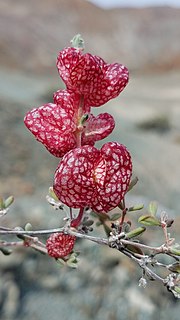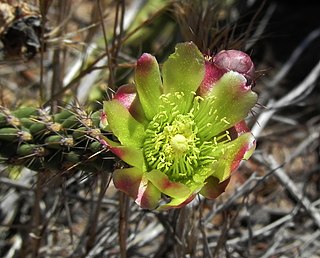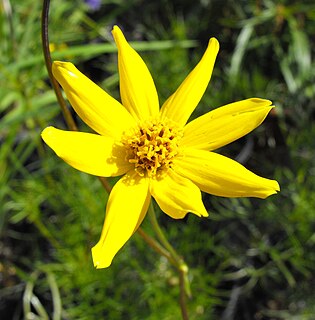
Fouquieria columnaris, the Boojum tree or cirio is a tree in the ocotillo family,(Fouquieriaceae) whose other members include the ocotillos. Some taxonomists place it in the separate genus Idria. It is nearly endemic to the Baja California Peninsula, with only a small population in the Sierra Bacha of Sonora, Mexico. The plant's English name, Boojum, was given by Godfrey Sykes of the Desert Laboratory in Tucson, Arizona and is taken from Lewis Carroll's poem "The Hunting of the Snark".

Cuscuta californica is a species of dodder known by the common names chaparral dodder and California dodder. This is an annual parasitic plant that may resemble fine strands of spaghetti or twine strewn across other species in its habitat. A mature plant of this species may fulfill all of its food and water needs from the host plant, but they rarely kill their host. It is native to western United States and Baja California in Mexico.

Emmenanthe is a monotypic genus which contains only one species, Emmenanthe penduliflora, known by the common name whispering bells. This grassland wildflower is native to California, though it can also be found in other locations within western North America.

Harfordia macroptera is a woody perennial in the family Polygonaceae commonly known as rabbit's purse. It is the sole species in the genus Harfordia, which is endemic to the Baja California Peninsula. This plant is characterized by a unique, conspicuous bladder embellished with red to purple veins that surround the fruit. The sac-like structure is actually a dramatically modified bract, and assists in dispersal of the seeds through the wind.

Eriogonum wrightii is a species of wild buckwheat known by the common names bastardsage and Wright's buckwheat. It is native to the Southwestern United States, California, and northwest Mexico, where it grows in many plant communities, such as chaparral, in rocky habitats from mountains to deserts.

Acmispon argophyllus, synonym Lotus argophyllus, is a species of legume native to California and northwest Mexico. It is known by the common name silver bird's-foot trefoil or silver lotus.

Cylindropuntia californica is a species of cholla cactus known by the common name snake cholla. It is primarily found in Baja California, Mexico and the southernmost part of California in the United States. It is characterized by a short, decumbent habit, yellow-green flowers, elongated stems, and short spines. It is mostly found in coastal sage scrub and coastal chaparral habitats, but two varieties in Baja California can be found in foothills and deserts. In California, variety californica is regarded as a rare and threatened plant, with a California Native Plant Society listing of 1B.1, in part due to its limited number of occurrences and threats from development. It formerly had a larger range due to the inclusion of Cylindropuntia bernardina within it as the variety parkeri.

Penstemon spectabilis is a species of penstemon known by the common name showy penstemon or showy beardtongue. It is native to southern California and Baja California, where it grows in the chaparral, scrub, and woodlands of the coastal mountain ranges.

Pilostyles thurberi is a species of endoparasitic flowering plant known by the common names Thurber's stemsucker and Thurber's pilostyles. It is native to the southwestern United States and northern Mexico, where it grows in desert and woodland. In the United States, P. thurberi has been recorded from the states of Arizona, California, New Mexico, Nevada, Texas.
Carterella is a monotypic genus of flowering plants in the family Rubiaceae. The genus contains only one species, viz. Carterella alexanderae, which is endemic to Baja California Sur in Mexico. It grows on steep slopes in the mountains.

Xylonagra arborea is a flowering plant endemic to the western side of the Baja California Peninsula. It is a bushy shrub distinguished by showy, scarlet flowers that are attractive to hummingbirds. It is the sole species in the genus Xylonagra, which belongs to the family Onagraceae.

Dudleya pauciflora is a species of succulent plant in the family Crassulaceae known by the common name few-flower liveforever. It is characterized by its small, crowded rosettes of narrow leaves, and its colorful inflorescence with strongly red-marked yellow flowers. Found growing on rocky outcrops and cliffs in the high elevation mountains of the Sierra de San Pedro Martir and the Sierra de San Borja, it is endemic to the state of Baja California, Mexico.

Jatropha moranii is a very rare subshrub in the genus Jatropha known commonly as Moran's lomboy. This species in the family Euphorbiaceae is endemic to a small area of Cabo San Lucas in Baja California Sur. It is characterized by a succulent stem and branches, along with a distinct woody caudex, and attractive white flowers.

Ibervillea sonorae is a tuberous perennial plant in the Cucurbitaceae family known by the common names wereke, wareque, guarequi, and coyote melon. It is a highly variable species characterized by a large, succulent tuberous root, which in the dry sand of its native habitat resembles a gray, dust-covered boulder. Emerging from the root yearly are long, flexible liana-like shoots, which reach a length of three or more meters. This species is native to northwestern Mexico, being found in the states of Baja California, Baja California Sur, Sonora and Sinaloa.

Nahuatlea aborescens is a species of tree in the Composite family endemic to the Cape region and Cerralvo Island of Baja California Sur, commonly known as ocote. It grows up to 8 meters tall, with monoecious tan-colored flowers and short, leafy branchlets. It was formerly in the genus Gochnatia, where it was known commonly as the tree gochnatia.

Lysiloma candidum, most commonly known as the palo blanco, is a tree of the family Fabaceae near-endemic to the Baja California Peninsula in Mexico. It may grow to a height of 10 metres (33 ft) and is one of the few spineless woody legumes in the region. It has compound leaves with oval gray-green leaflets. The creamy-white, globose clusters of flowers bloom in March through May and perfume the air with a light, spicy fragrance. The flowers are followed by red-brown pods up to 15 centimetres (5.9 in) long that hang delicately on the thin branches. This species is distributed throughout the Baja California Peninsula, from Rancho El Barril in southern Baja California state to the Cape region of Baja California Sur, and is also very rarely found in the state of Sonora.

Bidens nudata is a species of perennial plant in the family Asteraceae commonly known as the Cape beggar's tick or Baja tickseed. This species is endemic to the Sierra de la Laguna and the Sierra de las Cacachilas of Baja California Sur, Mexico. It is characterized by a mounding habit, pinnate green leaves and large yellow daisy-like flowers. This species has found uses in horticulture as an ornamental, providing a drought-tolerant and durable plant for the garden.

Jacquemontia abutiloides is a species of vining plant in the bindweed family (Convolvulaceae) commonly known as the felt-leaf clustervine or felt-leaf morning-glory. A perennial characterized by wooly leaves and blue to whitish flowers, this species grows as a woody plant to shrub with vining upper stems. Flowering is from September to June. It is near-endemic to the Baja California peninsula, Mexico, concentrated mostly around the central peninsula south of the Vizcaino Desert, and found on some of the coastal islands.

Lepechinia hastata is a rare species of perennial shrub in the mint family commonly known as the Cape pitcher sage or Baja pitcher sage. An aromatic plant, it is characterized by attractive magenta to purple flowers. The plant is slightly woody at the base, and has large arrowhead-shaped leaves. In the wild, it is only known from the forested mountains of the Sierra de La Laguna in Baja California Sur and the volcanic Socorro Island in the Pacific Ocean. The plants of Socorro Island represent their own subspecies. It is also found in the Hawaiian island of Maui where it is known as pakaha. It is unclear if the Hawaiian plants are introduced or represent a natural disjunct population. In horticulture, this plant is a widely-cultivated ornamental. It is one of three species of Lepechinia in the Baja California area, with the other two, Lepechinia ganderi and Lepechinia cardiophylla, found far to the north in drier chaparral habitat.

Schoepfia californica is a species of flowering plant in the Schoepfiaceae commonly known as the California schoepfia, iguajil, and candelillo. It is a large shrub or small tree with grayish bark, smooth turquoise-colored leaves, and small red flowers. It is endemic to the Baja California peninsula, and is commonly found in desert flats, slopes, and washes in an area from the Bahia de Los Angeles to the Cape region at the tip of the peninsula.





















